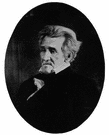Part 2: The White House and Beyond The people of the United States in 1824 couldn't quite make up their minds who they wanted to be president. Andrew Jackson got the most popular votes, but he didn't get enough Electoral Votes to make him president. The Electoral College, part of the Constitution, requires that a president have a certain percentage of the total votes cast. Jackson didn't have a high enough percentage. To get an Electoral College vote, each state totals up all its popular votes (like the ones adults you know cast on Election Day). The candidate who has the most popular votes in that state gets ALL of the Electoral votes for that state.
The Twelfth Amendment to the Constitution says that if no candidate gets more than 50 percent of the Electoral votes, then the House of Representatives must elect the president. This is exactly what happened in 1824. The representatives of each state voted as a group. Each state got one vote. During the House deliberations, Henry Clay, himself a Representative from Kentucky, agreed to give his support to John Quincy Adams. This was enough for the rest of the Representatives, who voted to elect Adams president. Taking
office amid such unpopularity didn't deter Adams, who pushed
ahead with a plan to develop thousands of miles of canals
and roadways to connect the far-flung territories of the
young country. (The The popular will was too much for him in 1828, and Andrew Jackson was elected. Just two years later, Adams was re-elected to the House of Representatives, where he served for 18 more years. He spoke out on Native American rights, on the advancement of science, on freedom of speech, and on the evil of slavery. In 1848, he died of a stroke on the House floor. First page > John Quincy Adams > Page 1, 2 |
|
Social Studies for Kids
copyright 2002–2025
David White

 So,
Andrew Jackson had the most votes, but he didn't have
enough. The Constitution said he had to get 50 percent of
the votes. The votes available at the time were 261. Jackson
had 99. He needed 127. Adams had 84. Crawford had 41. Clay
had 37.
So,
Andrew Jackson had the most votes, but he didn't have
enough. The Constitution said he had to get 50 percent of
the votes. The votes available at the time were 261. Jackson
had 99. He needed 127. Adams had 84. Crawford had 41. Clay
had 37.


